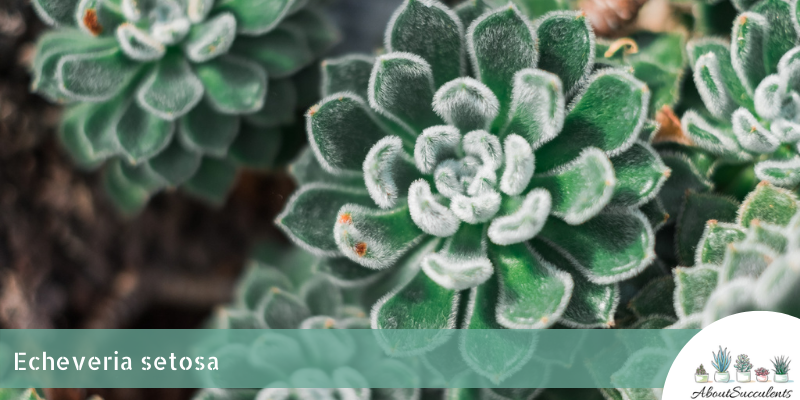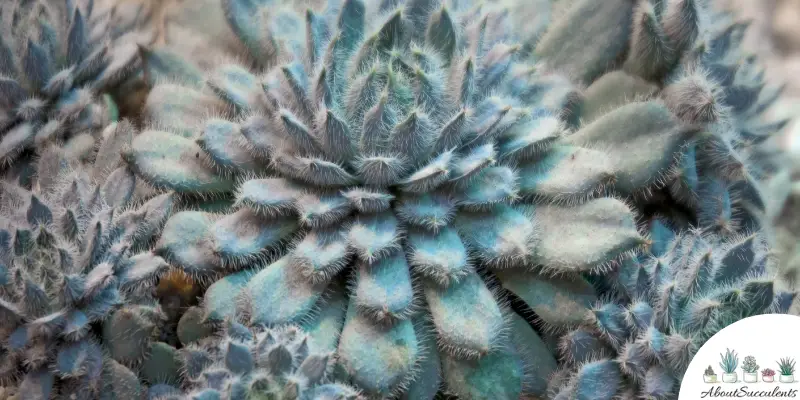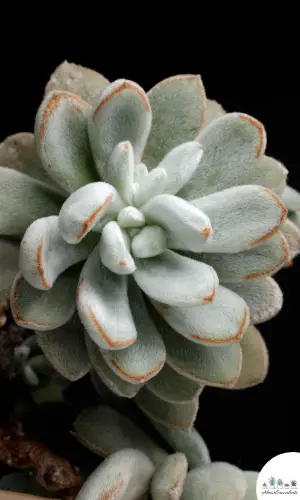
Echeveria setosa will surely open several pairs of eyes that encounter the strange but elegant-looking succulent that’s also known as Mexican Firecracker. This is an evergreen succulent that can light up any outdoor or indoor garden with its distinct features.
It’s no surprise that Mexican Firecracker is a recipient of the Award of Garden Merit of the Royal Horticultural Society.
Echeveria setosa is distinguished by a stemless rosette that grows up to 12-inches (30cm) wide and 3-inches (7cm) tall. Mexican Firecracker is packed with over a hundred, plump, spoon-shaped, green-colored leaves that are covered with short, thick, white hairs. The leaves grow up to 2.8-inches (7cm) long and 0.8-inches (2cm) wide.
As the plant matures, the offsets freely form a compact carpet of rose-like rosettes. In late spring, Echeveria setosa produces 30 cm (12”) tall stalks adorned with clusters of urn-shaped red flowers tipped with bright yellow hues.
A wonderful bonus for growers of Mexican Firecracker is that hummingbirds are drawn to these fragrant blossoms.
The Mexican Firecracker is native to Mexico. It is part of the Echeveria genus of the Crassulaceae family.
General Information
Also known as: Mexican Firecracker, Firecracker Echeveria, Firecracker plant
Plant Family: Crassulaceae
Origin: Semi-desert regions of Mexico
Height: 3-inches (7cm)
Exposure: Full sun for 6 hours every day.
Water Needs: Drought-tolerant; use the “soak and dry” watering method
Soil Type: Succulent soil mix or cactus mix combined with gritty materials such as perlite, pumice, coarse sand, and lava rocks.
Soil pH: 6.0
How to Grow and Care for Echeveria Setosa

Echeveria setosa is a low-maintenance plant and an excellent choice for new succulent growers.
The Mexican Firecracker thrives best outdoors where it can freely spread out as it grows. Many growers add these distinct-looking succulents to their Mediterranean or rock gardens and green roofs. It is also possible to grow them indoors.
Echeveria setosa is not cold-hardy, so if you live in an area where temperatures drop below -1.1 ° C (30° F) it’s best to plant them in containers.
Sunlight
Echeveria setosa needs at least 6 hours of exposure to the full sun every day to grow healthy. The leaves of the Mexican Firecracker get sunburnt easily so plant it in an area that is not exposed to the harsh midday sun.
If you prefer Echeveria setosa as an indoor succulent, you can place the pot near a South or West-facing window where it can bask in the light. Without enough sunlight, succulents will suffer from etiolation, a condition where the leaves stretch out as if they’re searching for sunlight.
Given this condition, Mexican Firecracker will lose its natural shape and vibrant hues. You can remedy the situation by gradually exposing the succulent to sunlight. Start out with partial sunlight for a few hours a day before giving Echeveria setosa a reinvigorating dose of direct sunlight.
Watering

Echeveria setosa is highly-tolerant to drought conditions because its leaves and stems store water. However, like all succulents, Mexican Firecracker is susceptible to the risks of overwatering.
When soil remains moist for a long time, it can develop fungi and other harmful bacteria. Likewise, the cells of Echeveria’s roots can rupture under prolonged exposure to moist conditions and rot. Once the roots have ruptured, fungi can find its way inside the succulent.
The best watering technique to adopt is the “soak and dry” method. Drench your soil with water and then allow it to fully dry out before you water it again.
Before you water, check the soil’s dryness by inserting a stick an inch deep. Pull out the stick and if it feels dry, the soil can receive water.
During the summertime, you might yourself giving Mexican Firecracker water every seven to 10 days. When winter comes around, the soil will stay moist longer. You might only water the soil once a month.
Pot and Soil
Echeveria succulents grow well in terracotta and ceramic pots. These pots are made with porous materials that allow proper soil aeration. To prevent water retention, choose pots with drainage holes.
The ideal pot size for your Echeveria setosa is 10% wider than your plant’s diameter. The depth of your pot should be about 10% bigger than your plant. Echeveria succulents do not have long roots so shallow bowl shape pots will do.
It is important to get the right size of pot because it can affect the growth of your succulents. Getting a pot that is too big for your plant will increase the chances of root rot. Since it holds more soil than the plant needs, it will retain more water. If you get a pot that is too small, the roots will not have enough room to grow.
For potting soil, use the standard succulent or cactus soil mix. Combine it with plenty of gritty materials such as coarse sand, perlite, crushed limestone, and gravel.
Fertilize your potted Echeveria Firecracker with a balanced liquid fertilizer diluted ½ strength once every two weeks when it is actively growing. Do not fertilize during winter when it is in its dormant phase.
How to Propagate Echeveria Setosa
Echeveria setosa can be propagated using leaf cuttings and offsets. The best time to propagate is during spring and summer.
Leaf Cuttings Method
Step 1: Gently pull the leaves or use a sharp sterile knife to cleanly cut the leaves from the mother plant.
Step 2: Place the leaf cuttings in a partially shaded area for 3 days or more to allow the cut wounds to be callous.
Step 3: Fill a shallow tray with cactus or succulent soil mix. Lay the leaf cuttings on top of the soil. Place the tray in a partially shaded, warm area. Mist the soil every day until the cuttings grow roots.
Step 4: Once rooted, transplant each leaf cutting in a new pot filled with cactus soil.
Offsets
Step 1: Gently pull an offset from the base of the mother plant.
Step 2: Shake off the soil from the roots and leave the offset for a few days in a shaded area.
Step 3: Fill ⅓ of a small terracotta pot with succulent or cactus soil combined with gritty materials. Plant the offset at the center of the pot and fill the pot with cactus soil.
Step 4: Place the pot in a well-lit area. Wait for a few days before watering the soil to allow the offset to acclimatize to its new home.
Frequently Asked Questions
Is Echeveria Setosa Toxic to Cats and Dogs?
No, Echeveria setosa is not included in the list of plants that are toxic to cats and dogs on the website of the American Society for the Prevention of Cruelty to Animals (ASPCA).
Why is my Echeveria Setosa Dying?
If your Echeveria setosa starts to fall apart and look unwell, your plant’s declining health may be due to the following:
Overwatering
The Echeveria species is highly sensitive to overwatering. If your plant sits on waterlogged soil for two days, the roots will start rotting away.
When the leaves of Mexican Firecracker turn yellow, transparent, and mushy, your plant is starting to die. You need to revive your plant immediately to keep it alive.
Gently remove the succulent from its pot and brush off all the soil from the roots. Use a sterile sharp knife or pruning shears to cut all the damaged roots and parts.
Lay your plant in a well-lit, dry area. Fill a terracotta pot with fresh succulent soil mix and perlite. Repot your Mexican Firecracker and wait for 5 days before you water the soil.
Should you reuse Echeveria’s former pot? We recommend using a new pot because the old pot might still contain fungi even if cleaned properly.
Pest Infestation
Echeveria setosa is prone to aphids and mealybugs infestation. These pests can drain the life out of your precious plants by drinking away its sap.
If you see white, cotton-like substances on your plant’s leaves, these are byproducts of mealybugs. Once you detect an infestation, isolate the affected plant.
To remove mealybugs and aphids, spray your plant with 70% isopropyl alcohol, or diluted neem oil. Spray the soil with neem oil to kill the eggs buried in there. You can also spray your plant with diluted liquid soap. Just add a few drops of liquid soap to 2 cups of water.
You will notice that the bugs and aphids will turn brown, die, and fall off the plant. Keep spraying your plant once a week until all the pests are gone. During treatment, do not expose your plant to direct sunlight to prevent sunburn and watermarks.
Some gardeners opt to use the natural remedy for mealybugs and aphids infestation. Ladybugs can help remove these pests when your plant is at the early stage of infestation.
Yes, Echeveria setosa produces clumps of urn-shaped red flowers with yellow tips in spring and summer. These fragrant flowers are beautifully stacked on foot-long stalks.
Last Updated on June 9, 2022 by Sofia Lara